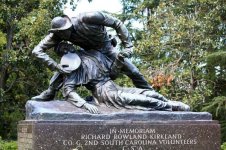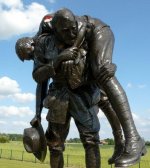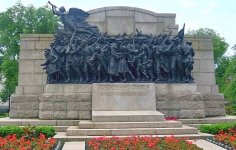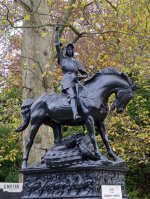You are using an out of date browser. It may not display this or other websites correctly.
You should upgrade or use an alternative browser.
You should upgrade or use an alternative browser.
Statues and Monuments (2 Viewers)
- Thread starter jazzeum
- Start date
Simpson & his donkey.
Sergeant Major
- Joined
- Feb 28, 2007
- Messages
- 1,801
Re: Forever Free
These are great statues of some great fighting men. Very impressive . Chris.
These are great statues of some great fighting men. Very impressive . Chris.
The Military Workshop
1st Lieutenant
- Joined
- Jul 31, 2005
- Messages
- 4,778
Re: Forever Free
Brad,
I note this is the second thread in a day where you have put up images from memorials to Union
soldiers. In both threads you just posted a title with an image and no comment. I am guessing there
are plenty of others that could be posted (even I could do it by searching Google). I dont understand
the point of putting up random images without a comment although the particular images you have
chosen seem to have a point to them. I even looked up Concord to see if it was a date
of significance yesterday. Perhaps if you were on a road trip it might be understandable.
It is not my Civil War but why dont you start a generic thread titled American Civil War Memorials and
Statues ? That way members can post images from all over and perhaps give a bit of the history from
each one.
Just a thought.
Regards
Brett
Brad,
I note this is the second thread in a day where you have put up images from memorials to Union
soldiers. In both threads you just posted a title with an image and no comment. I am guessing there
are plenty of others that could be posted (even I could do it by searching Google). I dont understand
the point of putting up random images without a comment although the particular images you have
chosen seem to have a point to them. I even looked up Concord to see if it was a date
of significance yesterday. Perhaps if you were on a road trip it might be understandable.
It is not my Civil War but why dont you start a generic thread titled American Civil War Memorials and
Statues ? That way members can post images from all over and perhaps give a bit of the history from
each one.
Just a thought.
Regards
Brett
Jack
Major
- Joined
- Dec 16, 2011
- Messages
- 6,347
Re: Forever Free
I think that the different interpretations possible of statues and memorials is what makes them fascinating. One Englishman, one American who has lived overseas (Spain I think Brad?), one expat Englishman residing in Australia having come via Hong Kong, two Australians and one donkey of indeterminant heritage do not necessarily share a common understanding of each other's national symbols. A statue of an Afro - American soldier (a term not in use when the statue was created) might celebrate emancipation or it could be a sad symbol of the fact that that emancipation did not bring with it political and economic equality. It could be an enduring symbol of freedom or a reminder of slavery and other, more modern injustices. Symbols can alter in significance over time, fall into irrelevance or be hijacked by other people. In another thread Tom mentioned the Confederate flag being hijacked by racist groups. What he sees symbolised in the flag is quite, quite different from these groups. The Japanese memorial to its dead of WW 2 is a sensitive issue with it being viewed by some as a reminder of Japan's war time record in SE Asia. I like the pictures of memorials and love discussing them but I understand that it is a point of contention for some and that they become part of modern political discussions.
I think that the different interpretations possible of statues and memorials is what makes them fascinating. One Englishman, one American who has lived overseas (Spain I think Brad?), one expat Englishman residing in Australia having come via Hong Kong, two Australians and one donkey of indeterminant heritage do not necessarily share a common understanding of each other's national symbols. A statue of an Afro - American soldier (a term not in use when the statue was created) might celebrate emancipation or it could be a sad symbol of the fact that that emancipation did not bring with it political and economic equality. It could be an enduring symbol of freedom or a reminder of slavery and other, more modern injustices. Symbols can alter in significance over time, fall into irrelevance or be hijacked by other people. In another thread Tom mentioned the Confederate flag being hijacked by racist groups. What he sees symbolised in the flag is quite, quite different from these groups. The Japanese memorial to its dead of WW 2 is a sensitive issue with it being viewed by some as a reminder of Japan's war time record in SE Asia. I like the pictures of memorials and love discussing them but I understand that it is a point of contention for some and that they become part of modern political discussions.
jazzeum
Four Star General
- Joined
- Apr 23, 2005
- Messages
- 38,446
Re: Forever Free
I had posted the photos without comment because I believe they speak for themselves, much as Mitch said and, as Jack pointed out, it can become, unfortunately, contentious. Thanks for the compliment Mitch.
However, I had long thought that a thread on statues and monuments, regardless of conflict, from the places where we live and visit could be interesting so I will start one or if anyone wants to beat me to the punch, by all means do so.
I had posted the photos without comment because I believe they speak for themselves, much as Mitch said and, as Jack pointed out, it can become, unfortunately, contentious. Thanks for the compliment Mitch.
However, I had long thought that a thread on statues and monuments, regardless of conflict, from the places where we live and visit could be interesting so I will start one or if anyone wants to beat me to the punch, by all means do so.
Jack
Major
- Joined
- Dec 16, 2011
- Messages
- 6,347
Re: Forever Free
Brad
I will wait for you to start the thread just in case it is an unpopular move! If not, I shall post regularly.
Jack
I had posted the photos without comment because I believe they speak for themselves, much as Mitch said and, as Jack pointed out, it can become, unfortunately, contentious. Thanks for the compliment Mitch.
However, I had long thought that a thread on statues and monuments, regardless of conflict, from the places where we live and visit could be interesting so I will start one or if anyone wants to beat me to the punch, by all means do so.
Brad
I will wait for you to start the thread just in case it is an unpopular move! If not, I shall post regularly.
Jack
johnnybach
Major General
- Joined
- Nov 24, 2010
- Messages
- 13,663
Re: Forever Free
I think it has already started Brad. At the risk of hi-jacking your excellent thread - and wonderful images - I would like to post something that illustrates just how contentious such monuments can be. I'm referring to the ANZAC Memorial - first built in Egypt by both Governments and also by subscription from ANZAC soldiers who contributed a days pay towards it. It was first unveiled in Egypt in 1932.
The monument was later torn to pieces by Egyptians during the riots which followed the Suez fiasco. Later rescued parts were shipped to Canberra, Australia and re-modelled and re-erected. It's "meaning" later became a bone of contentioun between NZ and Australia - because of a row over just what was being depicted.
An interesting read follows -and I think illustrates the point of " contentious meaning" nicely. As Jack alludes to - It isn't always "obvious" to various nations - or their citizens - just what is being represented, when a monument is placed in someone else's backyard. Johnnybach
http://www.nzmr.org/bess.htm
I think it has already started Brad. At the risk of hi-jacking your excellent thread - and wonderful images - I would like to post something that illustrates just how contentious such monuments can be. I'm referring to the ANZAC Memorial - first built in Egypt by both Governments and also by subscription from ANZAC soldiers who contributed a days pay towards it. It was first unveiled in Egypt in 1932.
The monument was later torn to pieces by Egyptians during the riots which followed the Suez fiasco. Later rescued parts were shipped to Canberra, Australia and re-modelled and re-erected. It's "meaning" later became a bone of contentioun between NZ and Australia - because of a row over just what was being depicted.
An interesting read follows -and I think illustrates the point of " contentious meaning" nicely. As Jack alludes to - It isn't always "obvious" to various nations - or their citizens - just what is being represented, when a monument is placed in someone else's backyard. Johnnybach
http://www.nzmr.org/bess.htm
GICOP
Four Star General
- Joined
- Oct 16, 2008
- Messages
- 28,100
Re: Forever Free
A statue to Gordon of Khartoum is just "up the road" from my house Brad {bravo}}
Cheers
Martyn
Jack and Johnny,
By all means do so. I will ask the Moderators to see if they can change the title.
I would think that in a country like England, for example, there must be tons of statues and monuments.
Brad
A statue to Gordon of Khartoum is just "up the road" from my house Brad {bravo}}
Cheers
Martyn
Jack
Major
- Joined
- Dec 16, 2011
- Messages
- 6,347
Re: Forever Free
I have seen the replica many times in Canberra along the avenue to the Australian War Memorial which is dotted with memorials to different groups and different conflicts.
The issue with the depiction of the New Zealander has always aggravated me. In terms of our wartime record we have often felt slighted when the gongs were given out (one of the reasons McArthur made no friends in Australia in WW2) and then we so regularly do it to our cousins across the Tasman. Well ... no one's perfect ... but the weather is great!
I think it has already started Brad. At the risk of hi-jacking your excellent thread - and wonderful images - I would like to post something that illustrates just how contentious such monuments can be. I'm referring to the ANZAC Memorial - first built in Egypt by both Governments and also by subscription from ANZAC soldiers who contributed a days pay towards it. It was first unveiled in Egypt in 1932.
The monument was later torn to pieces by Egyptians during the riots which followed the Suez fiasco. Later rescued parts were shipped to Canberra, Australia and re-modelled and re-erected. It's "meaning" later became a bone of contentioun between NZ and Australia - because of a row over just what was being depicted.
An interesting read follows -and I think illustrates the point of " contentious meaning" nicely. As Jack alludes to - It isn't always "obvious" to various nations - or their citizens - just what is being represented, when a monument is placed in someone else's backyard. Johnnybach
http://www.nzmr.org/bess.htm
I have seen the replica many times in Canberra along the avenue to the Australian War Memorial which is dotted with memorials to different groups and different conflicts.
The issue with the depiction of the New Zealander has always aggravated me. In terms of our wartime record we have often felt slighted when the gongs were given out (one of the reasons McArthur made no friends in Australia in WW2) and then we so regularly do it to our cousins across the Tasman. Well ... no one's perfect ... but the weather is great!
nysoldiers
Command Sergeant Major
- Joined
- Mar 15, 2008
- Messages
- 2,372
I think this is a great thread......historical, political, emotional and to some just giant toy soldiers!
Martin Tabony
Command Sergeant Major
- Joined
- Nov 6, 2009
- Messages
- 2,077
johnnybach
Major General
- Joined
- Nov 24, 2010
- Messages
- 13,663
Here's an interesting Monument in France - though search as you may - you won't find it there now. Well, not the top part anyway.
This was the monument to the 2nd Australian Division, erected in the French Town of Mont St. Quentin - a high spot overlooking the Somme. It was unveiled by Marshal Ferdinand Foche - who had been the Supreme Commander Allied Forces in France in 1918 - and unveiled in August 1925, to commemorate the fighting men of Australia who fought and died there. It depicts an AIF Digger bayoneting an Eagle, on it's back on the ground. The meaning of the monument was clear - it depicts the Australian Army defeating the Imperial German Army, symbolised by the dying bird of prey.
Fast forward a few years - and the German Army once again occupied the town during WW2. Little wonder then, that the bronze vanished shortly after they arrived - leaving just the plinth. And that's the way it stayed - until it was replaced, much later, in 1971, by a much less aggressive figure of a Digger in a slouch hat quietly looking downwards.
Well, we are all in Europe now - and times change. No-one wants anyone getting upset again - do they????? jb

This was the monument to the 2nd Australian Division, erected in the French Town of Mont St. Quentin - a high spot overlooking the Somme. It was unveiled by Marshal Ferdinand Foche - who had been the Supreme Commander Allied Forces in France in 1918 - and unveiled in August 1925, to commemorate the fighting men of Australia who fought and died there. It depicts an AIF Digger bayoneting an Eagle, on it's back on the ground. The meaning of the monument was clear - it depicts the Australian Army defeating the Imperial German Army, symbolised by the dying bird of prey.
Fast forward a few years - and the German Army once again occupied the town during WW2. Little wonder then, that the bronze vanished shortly after they arrived - leaving just the plinth. And that's the way it stayed - until it was replaced, much later, in 1971, by a much less aggressive figure of a Digger in a slouch hat quietly looking downwards.
Well, we are all in Europe now - and times change. No-one wants anyone getting upset again - do they????? jb

Martin Tabony
Command Sergeant Major
- Joined
- Nov 6, 2009
- Messages
- 2,077
BLReed
Sergeant Major
- Joined
- Nov 22, 2009
- Messages
- 1,676

This memorial is in the Confederate Cemetery in Fredericksburg , Virginia. In 1965, the magnificent statue sculpted by the famous artist Felix DeWeldon was unveiled in front of the Stone Wall in Fredericksburg.
Sgt. Richard Kirkland, Company G, Second South Carolina Infantry, titled "The Angel of Marye's Heights," during the Battle of Fredericksburg on Dec. 13, 1862. Daylight on the 14th revealed a ghastly scene to the Confederates behind the Stone Wall. About 8,000 Union soldiers had been shot in front of the wall and many of them remained where they had fallen. As hours went by without food, water or medical treatment, their suffering increased.
Nearby soldiers from both sides listened to the painful cries and pleas for help. While the suffering emotionally moved many, none dared face almost certain death to provide help.
At some point in the day, Kirkland could no longer bear listening to the pleas, so he walked over to the home of Martha Stevens. He went upstairs and told General Joseph Kershaw, his brigade commander, that he would like to try and help the wounded Union soldiers.
The surprised general at first refused the request, but he later relented.
Kirkland gathered all the canteens he could carry and filled them at the near by water well. Then, at extreme risk to himself, he ventured out to help the Federal soldiers. He carried water and warm clothing to the suffering Federal soldiers.
Also a book is available http://www.amazon.com/Angel-Maryes-Heights-Extraordinary-Fredericksburg/dp/0962306576/ref=cm_cmu_pg_t
Or you can go to http://en.wikipedia.org/wiki/Richard_Rowland_Kirkland
for the quasi-Cliff Notes version.
Charles Stadden made a 90mm figure titled "Angel of Mercy" Catalog number HP0169. I like the Stadden depiction better.
In color and includes the stone wall if for no other reason
Took me a while to get this one. Here's a catalog scan:
Jack
Major
- Joined
- Dec 16, 2011
- Messages
- 6,347
'Cobbers' commemorating the rescue of Australian troops after the slaughter of Fromelles.

The Australian Memorial Park is a World War I memorial, located near Fromelles, France commemorating Australians killed during the Battle of Fromelles.
The memorial park is located approximately 200 metres (660 ft) from the V.C. Corner Australian Cemetery and Memorial, on the same road in the direction of the village of Fromelles. It lies at the point where the German lines crossed the road, and has several surviving battlefield fortifications. In comparison, the V.C. Corner cemetery and memorial is approximately at the point where the Allied lines crossed the road.
The Memorial Park was opened on 5 July 1998 by Bruce Scott, the Australian Minister for Veterans' Affairs, in the presence of Ian McLachlan, the Australian Minister for Defence. The opening of this memorial park was part of a series of events that commemorated the 80th anniversary of the end of World War I. A guard of honour was provided by the French 43rd Infantry Regiment, and the Australian 10th/27th Battalion, and the opening of the memorial park was attended by hundreds from Australia and France.
Memorial Cobbers is a prominent 1998 sculpture by Peter Corlett of Sergeant Simon Fraser rescuing a wounded compatriot from No Man's Land after the battle.[4] A replica of the sculpture is in the Shrine of Remembrance in Melbourne, Victoria. The title comes from a letter that Fraser, a farmer from Byaduk, Victoria, wrote a few days after the battle and that was widely quoted in Australia's official history of World War I.
'We found a fine haul of wounded and brought them in; but it was not where I heard this fellow calling, so I had another shot for it, and came across a splendid specimen of humanity trying to wriggle into a trench with a big wound in his thigh. He was about 14 stone weight, and I could not lift him on my back; but I managed to get him into an old trench, and told him to lie quiet while I got a stretcher. Then another man about 30 yards out sang out "Don’t forget me, cobber." I went in and got four volunteers with stretchers, and we got both men in safely'.
http://www.ww1westernfront.gov.au/fromelles/fromelles-casualties.html

The Australian Memorial Park is a World War I memorial, located near Fromelles, France commemorating Australians killed during the Battle of Fromelles.
The memorial park is located approximately 200 metres (660 ft) from the V.C. Corner Australian Cemetery and Memorial, on the same road in the direction of the village of Fromelles. It lies at the point where the German lines crossed the road, and has several surviving battlefield fortifications. In comparison, the V.C. Corner cemetery and memorial is approximately at the point where the Allied lines crossed the road.
The Memorial Park was opened on 5 July 1998 by Bruce Scott, the Australian Minister for Veterans' Affairs, in the presence of Ian McLachlan, the Australian Minister for Defence. The opening of this memorial park was part of a series of events that commemorated the 80th anniversary of the end of World War I. A guard of honour was provided by the French 43rd Infantry Regiment, and the Australian 10th/27th Battalion, and the opening of the memorial park was attended by hundreds from Australia and France.
Memorial Cobbers is a prominent 1998 sculpture by Peter Corlett of Sergeant Simon Fraser rescuing a wounded compatriot from No Man's Land after the battle.[4] A replica of the sculpture is in the Shrine of Remembrance in Melbourne, Victoria. The title comes from a letter that Fraser, a farmer from Byaduk, Victoria, wrote a few days after the battle and that was widely quoted in Australia's official history of World War I.
'We found a fine haul of wounded and brought them in; but it was not where I heard this fellow calling, so I had another shot for it, and came across a splendid specimen of humanity trying to wriggle into a trench with a big wound in his thigh. He was about 14 stone weight, and I could not lift him on my back; but I managed to get him into an old trench, and told him to lie quiet while I got a stretcher. Then another man about 30 yards out sang out "Don’t forget me, cobber." I went in and got four volunteers with stretchers, and we got both men in safely'.
http://www.ww1westernfront.gov.au/fromelles/fromelles-casualties.html
Users who are viewing this thread
Total: 3 (members: 0, guests: 3)


![689px-African_America_Civil_War_Memorial,_Washington,_DC[1].jpg 689px-African_America_Civil_War_Memorial,_Washington,_DC[1].jpg](https://forum.treefrogtreasures.com/data/attachments/99/99132-89e756e6fb6a2d0d343614707979f4c1.jpg)
![865_USCTMonument[1].jpg 865_USCTMonument[1].jpg](https://forum.treefrogtreasures.com/data/attachments/99/99177-5194bade33756c346c5975926a3202d0.jpg)


